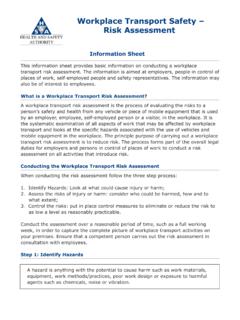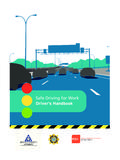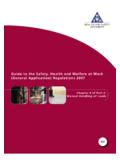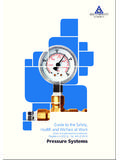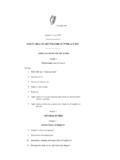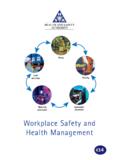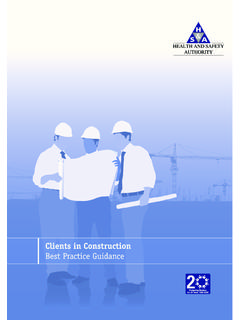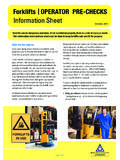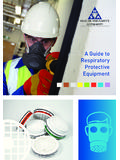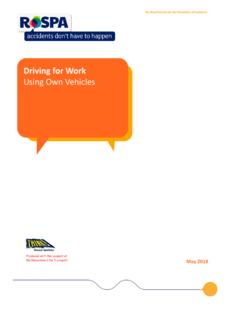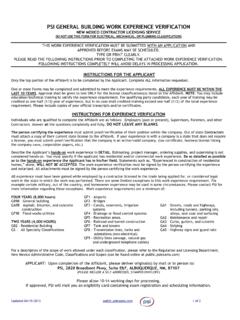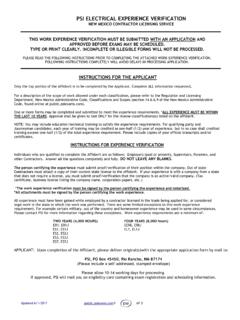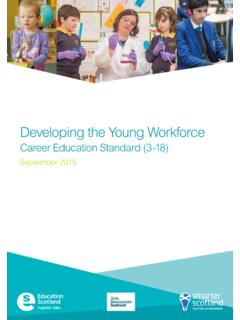Transcription of Work-Related Stress A Guide for Employers
1 Work-Related Stress A Guide for Employers Work-Related Stress A Guide for Employers Our vision: A national culture where all commit to safe and healthy workplaces and the safe and sustainable management of chemicals Work-Related Stress 2. A Guide for Employers 3. Contents 1. Introduction 4. 2. Defining Stress 5. 3. Defining work related Stress (WRS) 6. 4. Causes of WRS 7. 5. Effects of WRS 9. 6. European Approach 10. 7. Role of Employer 11. 8. Employee Duties and Involvement 12. 9. Prevention of WRS 13. 10. How to Approach WRS Systematically 14. 11. work Positive Risk Assessment Tool for WRS 16. 12. Conclusion 17. Appendix A Case Study 1 18. Appendix B Case Study 2 21. Work-Related Stress 4. A Guide for Employers 1. Introduction The Health and Safety Authority (HSA) is the state agency with responsibility for promoting health and safety at work in Ireland today. The subject of this Guide is work related Stress . We focus on ways to reduce its likelihood and its effects as well as ways to prevent short-term Stress becoming a long-term problem.
2 The focus of the HSA approach is on risk assessment and hazard reduction. This approach is reflected in the HSA's work Positive assessment tool, which aims at identifying potential risks, putting in place control measures and engaging with the workforce in a reasonable way to address hazards which can lead to workplace Stress . Queries on this issue come from employees, Employers and representative bodies and relate to many aspects of dealing with workplace Stress ; but the main source is, Employers who are looking for clarity on potential causes, suggested remedies and prevention strategies. Throughout this Guide , you will notice that the emphasis is on personal and relationship issues as the main source of Stress for individuals. While much of the Stress we experience comes from our personal lives, sometimes, a person's Stress - related condition, which may lead to ill-health and/or injury, can be caused by or made worse by work . work also has the potential to be beneficial for people's mental health and well-being.
3 For instance, being part of a team, achieving results, learning new skills and solving problems are all aspects of work which can add to people's sense of purpose and general life satisfaction. Under health and safety law, all workplaces should have, a current, operational Safety Statement which outlines the hazards and risks in that workplace and control measures put in place to eliminate or reduce them. All Employers should consider any workplace hazard where there is a reasonable probability that it could cause work related Stress . 5. 2. Defining Stress Stress can be broadly defined as the negative reaction people have to aspects of their environment as they perceive it. Stress is therefore a response to a stimulus and involves a sense of an inability to cope. We each perceive, interpret, cope with and react to the world differently, but a Stress reaction is an unpleasant state of anxiety. Two things should be kept in mind: firstly, being stressed is a state' and therefore not permanent in all but the most extreme cases; secondly, when we are stressed, or under the influence of Stress , we are less likely to behave in the rational way we do when we are calm.
4 How we manage pressure is influenced by many factors, some past, some current; how we learned, how others behaved around us when we were young, what behaviours were rewarded and what punished. We all cope better when we have support and when we have resources such as time, equipment, know-how and control. Causes of short-term Stress include tough deadlines, having to carry out tasks we find very difficult, having to do many things at once, or having to act in difficult circumstances or under external pressures for instance, when under extra emotional strain or feeling low or upset. Stress generally comes from aspects of personal lives; bereavement is a major cause of Stress , as is loss of any kind, including through divorce or separation. Other life events which are Stress -inducing include being ill or illness of a partner or family member, unemployment, financial pressure, running a business and indebtedness. Being stressed may not be articulated by everyone in the same way:for instance, although we all experience Stress through loss, people will explain the experience differently, cope with it differently, acknowledge it differently and recover from it in many different ways.
5 There are healthy ways to overcome Stress good lifestyle, diet, social solidarity, meaningful work which can broaden our social ties as well as unhealthy ways to react such as over- or under- eating, excessive drinking, angry outbursts, defensiveness which can lead to lack of quality sleep, decreased exercise and social isolation. Work-Related Stress 6. A Guide for Employers 3. Defining work related Stress (WRS). work related Stress (WRS) is Stress caused or made worse by work . It simply refers to when a person perceives the work environment in such a way that his or her reaction involves feelings of an inability to cope. It may be caused by perceived/real pressures/deadlines/threats/anxieties within the working environment. Stress occurs when an individual perceives an imbalance between the demands placed on them on the one hand, and their ability to cope on the other. It often occurs in situations characterised by low levels of control and support.' (Professor Tom Cox, I-WHO, University of Nottingham, UK).
6 Audits for hazards leading to Stress have become more and more commonly integrated into health and safety systems generally. This owes partly to the fact that Stress also has implications for Human Resource Management (HR), sickness absence management and occupational health generally. People behave differently when under pressure: Some people feel very threatened but keep it to themselves;. Others behave in very aggressive ways, without acknowledging that their behaviour is caused by Stress ;. Others react to the same issue in quite calm ways, feeling unthreatened and relaxed;. Others who are highly aware of their moods report that they are not very stressed by the issue, but enjoy its challenge;. Others have very low tolerance of any threats, and so find smaller, simpler demands made of them quite threatening and start feeling stressed as soon as these demands are made of them. It's not easy to establish the degree to which the work environment and factors outside of work contribute to an individual's Stress level.
7 Someone who is experiencing stressful life events may find that he or she is less able to cope with demands and deadlines at work , even though work is not the cause and had never been a problem before. Workplaces which have good communications, respectful relations and healthy systems of work can help people recognise and manage the type of Stress which may have more than one cause; such workplaces tend to get the best results in achieving a healthy and productive workforce. 7. 4. Causes of WRS. There are differences in underlying causes and triggers of WRS for everyone. However, some workplace factors are more likely to lead to Stress than others: badly designed shift work , poor communications, and poor or even non-existent systems for dealing with bullying and harassment can all increase levels of workplace Stress . Table 1 below sets out other potential causes. A person can experience WRS as a result of various factors, often with a number of factors occurring at the same time.
8 Some of these are a matter of the individual's perception in the moment, so we cannot assume automatically that the problem is the responsibility or fault of a system. Table 1: Contextual and content factors defining the hazard of WRS. (from I-WHO, UK*). CONTEXT TO work Potential Hazardous Conditions Organisational Poor communication, low levels of support for problem solving and personal culture development, lack of definition of organisational objectives. Role in organisation Role ambiguity and role conflict; responsibility for people unclear. Career stagnation and uncertainty, under or over promotion, poor pay, job insecurity, Career development low social value to work . Decision latitude/. Low participation in decision making, lack of control over work . control Interpersonal Social or physical isolation, poor relationships with superiors, interpersonal conflict, relationships at work lack of social support. Home- work interface Conflicting demands of work and home, low support at home, dual career problems.
9 CONTENT OF work Potential Hazardous Demands work environment Problems regarding the reliability, availability, suitability and maintenance or repair and equipment of both equipment and facilities. Lack of variety or short work cycles, fragmented or meaningless work , underuse Task design of skills, high uncertainty. Workload/pace work overload or underload, lack of control, over pacing, high level of time pressures. of work Poorly managed shift working, inflexible work schedules, unpredictable hours, work schedule long or unsocial hours. * Institute of work , Health & Organisations, University of Nottingham, UK. Work-Related Stress 8. A Guide for Employers Checklist of potential causes of WRS for employees: Role at work : is it clear and integrated, or do people often have conflicting roles? Relationships at work : is there constant strain and disharmony, or even open aggressive behaviour between people at work ? The hierarchies and leadership at work : are effective and fair management practices in place, supported by positive leadership?
10 Control: do people have some control over some aspects of what they do each day, or are they totally controlled, as though they were machines? Training: are people properly and adequately trained for the jobs they actually do? Demands: do employees have much more work to do than they are capable of doing to the standard, or within the time, expected? Some of the above factors can occur in any workplace, without leading to WRS; but when some are evident, and even more so when they occur simultaneously and are ongoing, there is a higher and increasing risk that one or more employees will begin to feel stressed. 9. 5. Effects of WRS. Usually, the effects of Stress can be categorised as follows: Mental (how the mind works);. Physical (how the body works);. Behavioural (the things we do);. Cognitive (the way we think and concentrate). The effects of Stress differ from individual to individual. Many factors influence the individual and his/. her interpretation of threat', response to threat and recuperation after a threatening experience .
